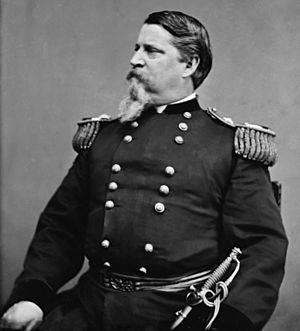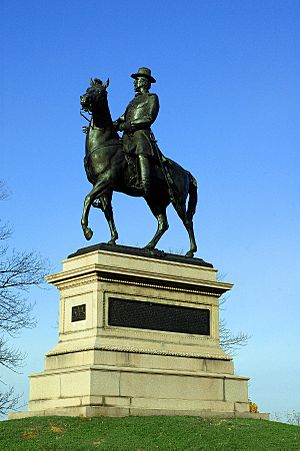Winfield Scott Hancock facts for kids
Quick facts for kids
Winfield Scott Hancock
|
|
|---|---|
 |
|
| Personal details | |
| Born | February 14, 1824 Montgomeryville, Pennsylvania, U.S. |
| Died | February 9, 1886 (aged 61) New York City, U.S. |
| Resting place | Montgomery Cemetery |
| Political party | Democratic |
| Spouse |
Almira Russell
(m. 1850) |
| Children | 2 |
| Education | United States Military Academy (BS) |
| Signature | |
| Nickname | Hancock the Superb |
| Military service | |
| Allegiance | |
| Branch/service | |
| Years of service | 1844–1886 |
| Rank | |
| Commands | II Corps |
| Battles/wars | Mexican-American War American Civil War |
Winfield Scott Hancock (February 14, 1824 – February 9, 1886) was an important U.S. Army officer. He served for 40 years in several wars and events. These included the Mexican-American War, the American Civil War, and the period of Reconstruction after the Civil War. He also helped the Army on the Western frontier.
Hancock was known as a war hero, especially for his actions at the Battle of Gettysburg. He was also a strong supporter of the Union and believed in states' rights. Because of his popularity, the Democratic Party chose him to run for President of the United States in 1880. He lost the election by a very small number of votes to Republican James A. Garfield.
Contents
Early Life and Military Training
Winfield Scott Hancock was born on February 14, 1824, in Montgomery Square, Pennsylvania. He had an identical twin brother named Hilary Baker Hancock. Their parents were Benjamin and Elizabeth Hancock. Winfield was named after Winfield Scott, a famous general who fought in the War of 1812 and the Mexican–American War.
Hancock graduated from the U.S. Military Academy in 1844. After West Point, he served under General Scott in the Mexican-American War. He fought in important battles like Contreras and Churubusco.
After the war, Hancock had several jobs in the army. He worked as a quartermaster, managing supplies, and as an adjutant, helping with administration. He was mostly stationed in St. Louis, Missouri. There, he met Almira ("Allie") Russell, and they got married on January 24, 1850. They had two children, Russell and Ada, but sadly, both children died before their parents.
Before the Civil War, Hancock also served in Florida during the Third Seminole War. He was also in Kansas during a time of conflict called "Bleeding Kansas." Later, he served in the Utah Territory and in California.
Winfield Hancock's Role in the Civil War
When the Civil War began in 1861, Hancock was assigned to serve under General William F. "Baldy" Smith in the Army of the Potomac. He quickly became known for his bravery and leadership. He earned the nickname "Hancock the Superb" during the Peninsula Campaign. This was because he led a very important counterattack in the Battle of Williamsburg.
Hancock also fought in other major battles, including the Battle of Antietam and the Battle of Fredericksburg. In July 1863, he was given command of a new corps (a large army unit) just before the Battle of Gettysburg.
Hancock's Heroism at Gettysburg
Hancock's most famous actions took place at the Battle of Gettysburg. On July 1, 1863, Major General George G. Meade, the new commander of the Army of the Potomac, learned that his friend, Major General John F. Reynolds, had been killed. Meade quickly sent Hancock ahead to take charge of the Union troops already fighting. Hancock's job was to figure out what was happening and organize the defenses.
Confederate forces were pushing the Union troops back through the town. Hancock quickly organized the Union defenses on Cemetery Hill. He had the power from Meade to order the troops to retreat, but he made the brave decision to stand and fight at Gettysburg. This decision was crucial for the Union victory.
On July 2, Hancock and his troops were positioned on Cemetery Ridge. Confederate General Robert E. Lee attacked both ends of the Union line. As more Confederate troops attacked, Hancock bravely rallied his defenses. He rushed units to the most critical areas where the fighting was heaviest. He even made the tough choice to order a regiment (a smaller army unit) to attack a Confederate brigade four times its size. This regiment suffered huge losses, with 87% of its soldiers becoming casualties. However, this sacrifice bought valuable time. It allowed the Union army to organize its defensive line and ultimately saved the day.
On July 3, Hancock remained in his position on Cemetery Ridge. He faced the full force of Pickett's Charge, a massive Confederate attack. During the charge, Hancock was shot and wounded. Despite his injury, he refused to leave the battlefield until the battle was over. His courage inspired his troops. Later, the U.S. Congress officially thanked him for his "gallant, meritorious, and conspicuous share" in the great victory at Gettysburg.
After the Civil War
Hancock suffered from the effects of his Gettysburg wound for the rest of his life. Even though he never fully recovered his old mobility, he continued to command troops. He led forces in several battles, including the Battle of the Wilderness, the Battle of Spotsylvania Court House, and the Siege of Petersburg. He was promoted to a higher rank, brevet major general, in the Regular Army in March 1865 for his service at Spotsylvania.
After the war, Hancock was involved in other important events:
- He oversaw the execution of the people who planned the assassination of President Abraham Lincoln.
- He commanded the US Department of the East, which was based in Governors Island, New York.
- He played a role in the Reconstruction period in the South. As commander of the Fifth Military District, he issued "General Order number 40." This order stated that military power should allow people to return to their normal lives. Many people in the South appreciated his approach.
Politics and Later Life
Because of his popularity and his views during Reconstruction, Winfield Scott Hancock was chosen as the Democratic candidate for president in the U.S. election of 1880. Many people in the Solid South voted for him because of General Order number 40. However, he was narrowly defeated by James A. Garfield.
Hancock remained active in public life. He was elected president of the National Rifle Association in 1881. He also led the MOLLUS, a veterans' organization, from 1879 until his death.
Winfield Scott Hancock, "Hancock the Superb," died on February 9, 1886. He was still commanding the Military Division of the Atlantic at the time. He had an infected carbuncle (a type of boil) that was made worse by diabetes. He is buried in Montgomery Cemetery in Norristown, Pennsylvania.
Memorials to Winfield Scott Hancock
Winfield Scott Hancock is remembered with several statues and memorials:
- An equestrian statue (showing him on a horse) on East Cemetery Hill at the Gettysburg Battlefield.
- A portrait statue as part of the Pennsylvania Memorial at Gettysburg.
- A special carving (called an alto-relievo) on the New York State Monument at Gettysburg. This carving shows him being wounded during Pickett's Charge.
- An equestrian statue in Market Square in Washington, D.C..
- Another equestrian statue on top of the Smith Civil War Memorial in Fairmount Park, Philadelphia, Pennsylvania.
- A large bronze bust (a sculpture of his head and shoulders) in Hancock Square, New York City.
Interesting Facts About Winfield Scott Hancock
- Hancock had an identical twin brother named Hilary Baker Hancock.
- Before the Civil War, when he was a commander in the West, he supported fair treatment for Native American tribes.
- Hancock became good friends with Lewis Armistead while they were stationed in Southern California. Later, they faced each other in battle during Pickett’s Charge at Gettysburg.
- People often called him "Hancock the Superb" because of his excellent leadership.
- He is a character in Michael Shaara's historical novel The Killer Angels. This book was made into a movie called Gettysburg in 1993.
Images for kids
See also
 In Spanish: Winfield Scott Hancock para niños
In Spanish: Winfield Scott Hancock para niños



